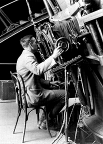The Hidden Lives of Galaxies - Introduction
The Hidden Lives of Galaxies
Looking up at the sky at night, we see a small display of stars which are a part of our Milky Way Galaxy. A galaxy consists of a multitude of billions of stars. Our Sun is part of a solar system, which belongs to a large family of more than 100 billion stars. According to the Big Bang theory, when the universe was created, all the matter in the universe was distributed uniformly, but within that uniformity, there existed clumps of matter. Over very long periods of time, through the action of gravity, these clumps acquired more surrounding matter and grew. Galaxies began to form when large clouds of gas and dust condensed. When very large clouds of gas condense through gravity, stars formed.
Introduction
 |
| Edwin Hubble |
In the 19th century, astronomers thought that the Milky Way was the only galaxy in the universe. The introduction of telescopes to the study of astronomy opened up the universe, but it took some time for astronomers to realize the vastness of the universe. Telescopes were used to make dim objects in the sky look brighter and small objects look larger. There are two types of telescopes: a refractor, which uses a lens to collect light, and a reflector, which uses a mirror to collect light. Telescopes revealed that our night sky was not only populated with stars, but with other objects which appeared like faint, patchy clouds. These objects were nebulae that seemed to be within our Galaxy, the Milky Way, and thus believed to be relatively close. But as telescopes became more powerful, it was possible to see different structures in the nebulae.
Astronomers debated the nature of these nebulae. The question became whether these objects were within the Milky Way Galaxy, or whether they were stellar communities distinct from our Galaxy. It wasn't until the 1920's that the American astronomer, Edwin Hubble, ended the debate by discovering that some of the nebulae were composed of stars. Hubble also determined the distances to these particular nebulae, and found that they were far outside our Galaxy. Thus, these were found to be individual galaxies. Scientists now estimate that there are about 200 billion galaxies of various types in the universe.
Recommended Activity: How Big is the Universe?

